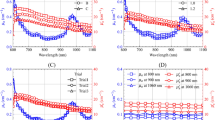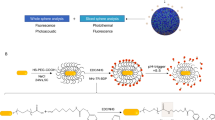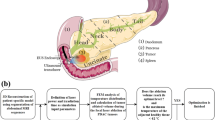Abstract
The investigation of laser-tissue interaction is crucial for diagnostics and therapeutics. In particular, the estimation of tissue optical properties allows developing predictive models for defining organ-specific treatment planning tool. With regard to laser ablation (LA), optical properties are among the main responsible for the therapy efficacy, as they globally affect the heating process of the tissue, due to its capability to absorb and scatter laser energy. The recent introduction of LA for pancreatic tumor treatment in clinical studies has fostered the need to assess the laser-pancreas interaction and hence to find its optical properties in the wavelength of interest. This work aims at estimating optical properties (i.e., absorption, μ a , scattering, μ s , anisotropy, g, coefficients) of neuroendocrine pancreas tumor at 1064 nm. Experiments were performed using two popular sample storage methods; the optical properties of frozen and paraffin-embedded neuroendocrine tumor of the pancreas are estimated by employing a double-integrating-sphere system and inverse Monte Carlo algorithm. Results show that paraffin-embedded tissue is characterized by absorption and scattering coefficients significantly higher than frozen samples (μ a of 56 cm−1 vs 0.9 cm−1, μ s of 539 cm−1 vs 130 cm−1, respectively). Simulations show that such different optical features strongly influence the pancreas temperature distribution during LA. This result may affect the prediction of therapeutic outcome. Therefore, the choice of the appropriate preparation technique of samples for optical property estimation is crucial for the performances of the mathematical models which predict LA thermal outcome on the tissue and lead the selection of optimal LA settings.





Similar content being viewed by others
References
Malvezzi M, Bertuccio P, Rosso T, Rota M, Levi F, La Vecchia C et al (2015) European cancer mortality predictions for the year 2015: does lung cancer have the highest death rate in EU women? Ann Oncol 26:779–786
International Agency for Research on Cancer, http://eco.iarc.fr/
Bosman FT (2010) WHO classification of tumours of the digestive, Lyon, IARC Press, 4th edition.
Stathis A, Moore MJ (2010) Advanced pancreatic carcinoma: current treatment and future challenges. Nat Rev Clin Oncol 7:163–172
Di Matteo F, Martino M, Rea R, Pandolfi M, Rabitti C, Masselli GMP, Silvestri S et al (2010) EUS-guided Nd: YAG laser ablation of normal pancreatic tissue: a pilot study in a pig model. Gastrointest Endosc 72:358–363
Di Matteo FM, Picconi F, Martino M, Pandolfi M, Pacella CM, Schena E, Costamagna G (2014) EUS-guided Nd:YAG laser ablation of recurrent pancreatic neuroendocrine tumor: a promising revolution? Endoscopy 46:E380–E381
Vogl TJ et al (2002) Malignant liver tumors treated with MR imaging-guided laser-induced thermotherapy: experience with complications in 899 patients (2,520 lesions). Radiology 225:367–377
Pacella CM et al (2004) Thyroid tissue: US-guided percutaneous laser thermal ablation. Radiology 232:272–280
Jacques SL (2013) Optical properties of biological tissues: a review. Phys Med Biol 58:R37
Paulides M, Stauffer P, Neufeld E, Maccarini P, Kyriakou A, Canters R, Diederich C, Bakker JF, Van Rhoon G (2013) Simulation techniques in hyperthermia treatment planning. Int J Hyperthermia 29:346–357
Wilson BC, Patterson MS, Flock ST (1987) Indirect versus direct techniques for the measurement of the optical properties of tissues. Photochem Photobiol 46:601–608
Palmer GM, Ramanujam N (2006) Monte Carlo-based inverse model for calculating tissue optical properties. Part I: theory and validation on synthetic phantoms. Appl Opt 45:1062–1071
Hammer M, Roggan A, Schweitzer D, Muller G (1995) Optical properties of ocular fundus tissues—an in vitro study using the double-integrating-sphere technique and inverse Monte Carlo simulation. Phys Med Biol 40:963
Roggan A, Schädel D, Netz U, Ritz JP, Germer CT, Mueller GJ (2001) Effect of preparation technique on the optical parameters of biological tissue. International Society for Optics and Photonics, Saratov Fall Meeting, pp 186–199
Kiris T, Akbulut S, Kiris A, Gucin Z, Karatepe O, Ates GB, Tabakoğlu HÖ (2015) Optical characterization of pancreatic normal and tumor tissues with double integrating sphere system. International Society for Optics and Photonics, SPIE BiOS, pp 932116–932116
Niemz MH (2004) Laser-tissue interactions, Fundamentals and Application. 3th edition, Springer, 9.
Tuchin VV, Tuchin V (2007) Optical properties of tissue with multiple (strong) scattering, in Tissue optics: light scattering methods and instruments for medical diagnosis , SPIE press, Bellingham, 3
Lee T, Mendhiratta N, Sperling D, Lepor H (2014) Focal laser ablation for localized prostate cancer: principles, clinical trials, and our initial experience. Rev Urol 16:55–66
Di Costanzo GG, Francica G, Pacella CM (2014) Laser ablation for small hepatocellular carcinoma: state of the art and future perspectives. World J Hepatol 6:704
Stafford RJ, Fuentes D, Elliott AA, Weinberg JS, Ahrar K (2010) Laser-induced thermal therapy for tumor ablation. Crit Rev Biomed Eng 38:79–100
Saccomandi P, Vogel V, Bazrafshan B, Maurer J, Schena E, Vogl TJ, Silvestri S, Mäntele W (2015) Estimation of anisotropy coefficient of swine pancreas, liver and muscle at 1064 nm based on goniometric technique. J Biophotonics 8:422–428
Saccomandi P, Vogel V, Bazrafshan B, Schena E, Vogl TJ, Silvestri S, Mäntele W (2014) Estimation of anisotropy coefficient and total attenuation of swine liver at 850 nm based on a goniometric technique: influence of sample thickness. Engineering in Medicine and Biology Society, EMBC, 36th Annual International Conference of the IEEE 2014:5332–5335
Saccomandi P, Schena E, Massaroni C, Di Matteo FM, Silvestri S (2015) Goniometric measurement for the estimation of anisotropy coefficient of human and animal pancreas. Engineering in Medicine and Biology Society, EMBC, 37th Annual International Conference of the IEEE: 1283-1286.
Diagnostic Histopathology of tumors, 4th Edition. Editor Dr. Christopher Fletcher’s.
Yust BG, Mimun LC, Sardar DK (2012) Optical absorption and scattering of bovine cornea, lens, and retina in the near-infrared region. Lasers Med Sci 27:413–422
Wang L, Jacques SL, Zheng L (1995) MCML—Monte Carlo modeling of light transport in multi-layered tissues. Comput Meth Prog Bio 47:131–146
Prahl SA, Keijzer M, Jacques SL, Welch AJ (1989) A Monte Carlo model of light propagation in tissue (University of Texas), ed. SPIE.
http://omlc.org/software/mc/
Saccomandi P, Schena E, Giurazza F, Del Vescovo R, Caponero MA, Mortato L, Panzera F, Cazzato RL, Grasso FR, Di Matteo FM, Silvestri S, Beomonte Zobel B (2014) Temperature monitoring and lesion volume estimation during double-applicator laser-induced thermotherapy in ex vivo swine pancreas: a preliminary study. Lasers Med Sci 29:607–614
Saccomandi P, Schena E, Caponero MA, Di Matteo FM, Martino M, Pandolfi M, Silvestri S (2012) Theoretical analysis and experimental evaluation of laser induced interstitial thermotherapy in ex vivo porcine pancreas. IEEE Trans Biom Eng 59:2958–2964
Kim A, Wilson BC (2011) Measurement of ex vivo and in vivo tissue optical properties: methods and theories, in Optical-thermal response of laser-irradiated tissue, eds. Welch AJ, and Van Gemert MJC, pp. 267–320, vol. 2. Springer, Berlin
Astgheib S, Irajie C, Assaei R, Koohpeima F, Mokarram P (2014) Optimization of RNA extraction from rat pancreatic tissue. Iran J Med Sc 39:282–8
Müller G, Roggan A (1995) Laser-induced interstitial thermotherapy. SPIE Press
Author information
Authors and Affiliations
Corresponding author
Ethics declarations
Conflict of interest
The authors declare that they have no conflicts of interest.
Appendix
Appendix
The power deposition in tissue causes temperature increase that can be estimated by the bioheat equation [28, 29]:
where ρ is the density [kg m−3], c is the specific heat [J kg−1 K−1] and k is the heat conductivity [W m−1 K−1] of tissue. T(x,y,z,t) is the tissue temperature, function of spatial coordinates x, y, and z and of time, t [s]. Tissue is assumed to be homogeneous and isotropic to make the heat transfer analysis more feasible and to maintain generality. Other terms in Eq. 3 are as follows:Q b [W m−3], the heat absorption due to blood perfusion per volume unit in the tissue:
where ρ b is the density [kg m−3], c b the specific heat [J kg−1 K−1], w b the perfusion rate per volume unit [s−1], and T b the temperature of blood;Q l [W m−3], the laser heat source term, related to tissue optical properties according to the Lambert-Beer law:
The effective attenuation coefficient, μ eff, determines the amount of laser energy converted into heat due to light penetration and depends on μ a , μ s , and g (Eq. 6):
Constant values are as follows: for pancreas, ρ = 1040 kg m−3, c = 3590 J kg−1 K−1, and k = 0.5417 W m−1 K−1; for blood, ρ b = 1060 kg m−3, c b = 3640 J kg−1 K−1, and w b = 0.03 s−1.Laser settings are as follows: laser power density (P d) 8 W cm−2 and treatment time 200 s. Simulations are implemented in Comsol Multiphysics® environment, considering a 3D cylindrical geometry. Initial tissue and blood temperature, as well as boundary conditions, are 310 K.
Rights and permissions
About this article
Cite this article
Saccomandi, P., Larocca, E.S., Rendina, V. et al. Estimation of optical properties of neuroendocrine pancreas tumor with double-integrating-sphere system and inverse Monte Carlo model. Lasers Med Sci 31, 1041–1050 (2016). https://doi.org/10.1007/s10103-016-1948-1
Received:
Accepted:
Published:
Issue Date:
DOI: https://doi.org/10.1007/s10103-016-1948-1




